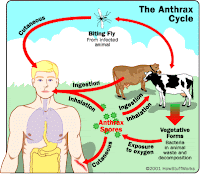Anthrax, contagious disease of warm-blooded animals, including humans, caused by the bacterium Bacillus anthracis. One of the oldest known diseases, it was once epidemic and still appears in many world areas, but only sporadically in the western and southern United States. It was the first disease for which the causative organism was isolated, by C. J. Davaine in 1863, for which a pure culture was obtained, by Robert Koch in 1876, and for which an effective vaccine was developed, by Louis Pasteur in 1881 - Anthrax .
Animals acquire the disease from drinking water draining from contaminated soil, in which the organism may live for years; from eating infected carcasses and feedstuffs; and from the bites of bloodsucking insects. The disease, sometimes manifested by staggering, bloody discharge, convulsions, and suffocation, may be fatal almost immediately in acute cases and within three to five days in subacute cases. Death is caused by toxemia. Preseasonal inoculations and antibiotics are effective.
In humans, the disease appears in both external and internal forms, with a death rate of about 20 percent. The external or cutaneous form is contracted through cuts or abrasions in the skin by those who handle infected hides and carcasses and may be self-limiting, but often disseminates into the bloodstream, with fever and prostration. It is characterized by malignant pustules on exposed skin areas. The internal type is acquired by inhaling anthrax spores, as from animal hair and wool, which invade the lungs and sometimes the intestinal tract to cause hemorrhage - Anthrax .
It is speculated that an intestinal variety may be caused by consuming contaminated meat or milk. Workers exposed to animal products, especially wool, are protected by vaccination. Penicillin and tetracyclines are effective in treatment except in rapidly progressing cases. medical terminology
by : Emil
Terima kasih untuk Like/comment FB :
